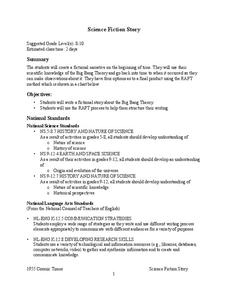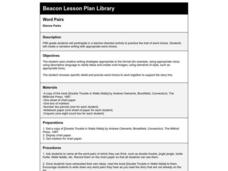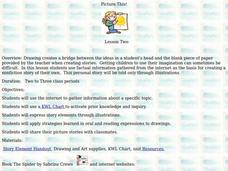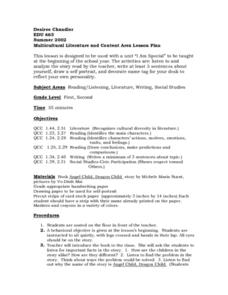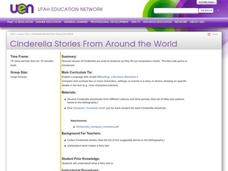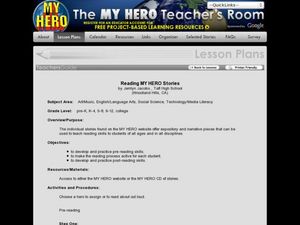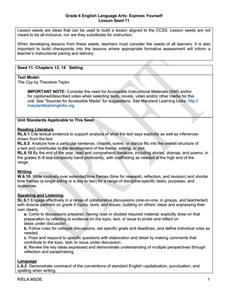Curated OER
Dr. Heidegger's Experiment
What are the pros and cons of prolonging life? Incorporate real-world issues into the study of literature using Dr. Heidegger's Experiment. Through the exploration of pre-determined websites, scholars consider several related...
Curated OER
Cops and Robbers
Second graders observe the teacher model writing a letter to the author of the book, COPS AND ROBBERS. They then compare the story structure of the book to those of FUNNYBONES and identify the setting, characters and theme.
Curated OER
Build Mastery: Main Idea
Use a graphic organizer to get readers thinking about main ideas as they record the who, what, where, when, and why of a story. Consider modeling this process completely before kids do this independently. They fill in five boxes charting...
NASA
Science Fiction Story
A lesson allows you to go back in time and see the big bang actually happen. Bazinga! In reality, pupils research the Big Bang Theory and theorize what it would be like to go back in time and see it happen. There are four...
Student Achievement Partners
Eleven
Turning 11 comes with a range of emotions. Explore those emotions by reading the short story "Eleven" by Sandra Cisneros. Readers analyze the main character's reactions to the events of her day. Then, they write an essay describing what...
Curated OER
Come On, Rain!
Young scholars read and analyze the story. In this language arts lesson, students read Come on, Rain! and examine how mood and tone are created, the use of figurative language and the characteristics of the genre. Young scholars...
Curated OER
Word Pairs
Fifth graders practice the trait of word choice and create a narrative writing with appropriate word choices. They work in pairs to write a story using as many word pairs from their imaginations as they can.
Curated OER
The Name Jar
Students participate in a lesson that focuses on the literature of Korea. "The Name Jar" is read by students to practice some essential reading skills. This would include the recognition of sequence in a story, characterization, and...
Curated OER
Reading The Great Kapok Tree
Students complete story frames to demonstrate understanding of plot development and conflict resolution.
Curated OER
Figurative Language and Symbolism
Students identify figurative language and symbolism in poetry as well as prose. In this literary elements lesson, students read and discuss the role of symbolism in Yellow Man by Moonlight, A Christmas Carl, The House of Wings, and...
Curated OER
Picture This
Students explore finding facts from the Internet to create a nonfiction story. In this writing lesson, students fill out KWL charts and do internet research about the given topic of spiders. Students then create and illustrate...
Curated OER
Chrysanthemum
Students identify the main story elements in the book Chrysanthemum by Kevin Henkes. In this literacy activity, students listen to the book and use a guided reading ball check for comprehension. Students answer questions such as "Who are...
Curated OER
"Angel Child, Dragon Child"
Students read and analyze the book "Angel Child, Dragon Child" by Michele Maria Surat. They chart the main story elements on a graphic organizer, and write three sentences about themselves and draw a self-portrait. Students then create...
Curated OER
The Magic Pot
For this reading comprehension lesson, students use the book "The Magic Pot," to explore many concepts including; story elements, sequencing, and phonics. Students also practice making doubles using coins and "magic pots." This very...
Curated OER
Introduce Vocabulary: Clap Your Hands
Read Clap Your Hands to explore new vocabulary with your class. In this three-tiered vocabulary lesson plan, youngsters read the book and identify the plot, setting, and characters. They also define vocabulary terms from the book...
Curated OER
Cinderella Stories From Around the World
Fifth graders review the basic story of the Cinderella fairy tale. In groups, they read various stories of Cinderella from different cultures. They use a compare and contrast chart to examine the differences between the American...
Curated OER
Cinderella Stories From Around the World
Fifth graders are read a variety of Cinderella stories from around the world. In groups, they complete a comparison chart for each story and how it compares to the American version. To end the lesson, they participate in a fairy tale...
Curated OER
Reading My Hero Stories
Learners use the My Hero website to help them develop their reading skills. They create a KWL chart for the hero of their choice.
Cleveland Metro School District
Novel Lesson for The Giver
Lois Lowry's The Giver is one of the most engaging and thought-provoking works of literature in the middle school curriculum. Round out your novel unit with a collection of reading activities, comprehension questions, memoir and...
Curated OER
Express Yourself Lesson Seed 11: Setting
Encourage your learners to examine the setting in Theodore Taylor's The Cay. Pupils work in small groups to put together a description of the setting before reading two more chapters of the book. They use their double-entry journals to...
Read Works
Climax of a Story
Demonstrate how to track the elements of plot in a story. After watching you mark down the rising action, problem, climax, falling action, and resolution for Stone Soup by Jon J. Muth, pupils complete a graphic organizer for Sweet...
Curated OER
Plot Development
Young scholars identify the elements of plot and write a script with a strong plot. In this plot instructional activity, students identify elements of plot in examples by completing a chart and a graphic organizer. Young...
Curated OER
Major and Minor Characters
In this reading worksheet, students complete a chart about two characters from a book. Information includes the character names, how they look, how they act, how they interact with others, and how the student might relate to them.
Curated OER
Laurence Yep's, Dragonwings
Learners discuss vocabulary words and compare definitions. They read chapters 6-9 of the novel, Dragonwings, and discuss point of view, and complete a plot diagram. Then they review the four types of conflict and identify the conflicts...



